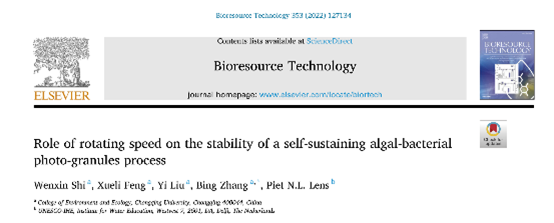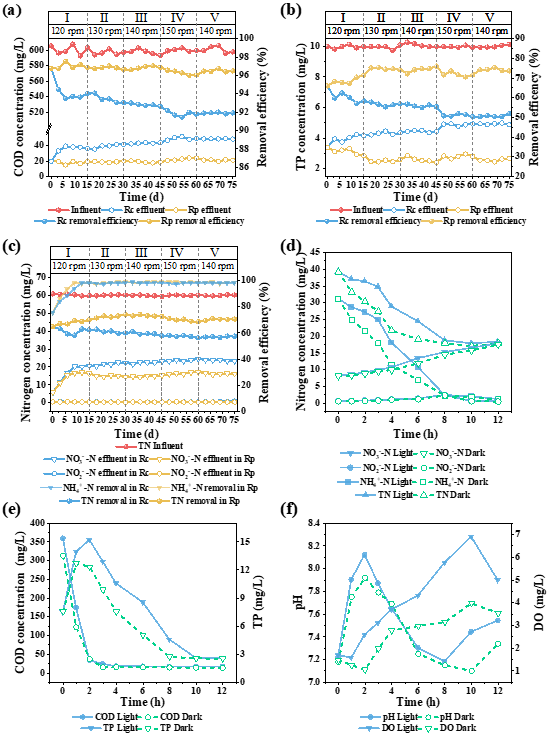2022-05-08 22:26:30
Professor SHI Wenxin’s team from the College of Environment and Ecology, has newly published a study on algal-bacterial granular sludge (ABGS) inBioresource Technology(BITE; IF9.642), a top academic journal in the field of environment. This paper “Role of rotating speed on the stability of a self-sustaining algal-bacterial photo-granules process” has been selected for Cover Image of Volume 353 by the editor office. According to the rules, BITE published a figure as the best paper figure on the cover page of the journal. The figure is selected from one of the best papers published in the issue.

Cover Image of Volume 353, Bioresource Technology

https://doi.org/10.1016/j.biortech.2022.127134
Graphic Abstract

Abstract
The effects of rotating speed (120, 130, 140 and 150 rpm) of a photo-reactor on the self-sustaining algal-bacterial photo-granules sludge (ABPG) was investigated in this study. The ABPG process maintained good granular stability at 140 rpm with an integrity coefficient of 3.0% and excellent nutrient removal. The increases of the extracellular polymeric substances (EPS) content, the portions of α-helix (32.37%) in the secondary protein structure, and the relative abundance of functional bacteria (e.g. Candidatus_Competibacter), contributed to the maintenance of granular structure stability. However, the lower rotating speed (120 and 130 rpm) resulted in slow bacterial growth and reproduction while a higher rotating speed (150 rpm) caused the disintegration of photo-granules. Overall, the results reveal the influencing mechanisms of photo-reactor rotating speed on the self-sustaining ABPG process and provide an effective approach to maintain the system stability.
Aims
In this study, the effects of different rotating speeds on the physicochemical characteristics, morphology and micro-structure, nutrient removal performance, and structural stability of ABPG were investigated, with the conventional AGS as the control. The influencing mechanisms were revealed by analyzing the EPS content and components, the microbial community structure, and the predicting metagenomic information using phylogenetic investigation of communities by reconstruction of unobserved states (PICRUSt). The results provide an in-depth understanding of the effects of rotating speed on the ABPG process, and the optimal rotating condition for the stability of a self-sustaining ABPG process.

Fig. 2. Variations of COD removal efficiency (a), TP concentration (b), and TIN removal efficiency (c) in Rc and Rp at phases I-Ⅴ. Variations of N species (d), COD and PO43--P (e), and DO and pH (f) in Rp during the typical light and dark cycles at phase V (140 rpm).
Conclusions
Compared to the conventional AGS, the ABPG process was significantly affected by the rotating speed. The performance of ABPG was improved with the increase of rotating speed from 120 rpm to 140 rpm. However, the stability of ABPG was damaged when the rotating speed was increased to 150 rpm. The effects of rotating speed on the stability of ABPG system were mainly reflected by influencing the proliferation of microorganisms, the relative abundance of the functional bacteria and the secretion of EPS. Overall, this study provides an effective approach to improve the stability of ABPG by optimizing the operational rotating speed.